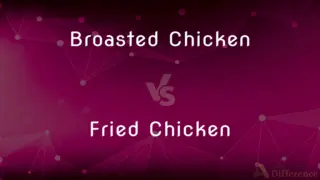Ventricular Tachycardia vs. Ventricular Fibrillation — What's the Difference?
By Urooj Arif & Fiza Rafique — Published on March 7, 2024
Ventricular tachycardia is a fast, regular heart rhythm originating in the ventricles, while ventricular fibrillation is a rapid, chaotic heart rhythm that can be life-threatening, leading to cardiac arrest if not treated immediately.

Difference Between Ventricular Tachycardia and Ventricular Fibrillation
Table of Contents
ADVERTISEMENT
Key Differences
Ventricular tachycardia (VT) is characterized by a fast but regular heart rate that starts from the ventricles, the heart's lower chambers. It can cause significant symptoms but often maintains enough cardiac output to sustain life, at least temporarily. In contrast, ventricular fibrillation (VF) is an irregular and uncoordinated quivering of the ventricles, resulting in the heart's inability to pump blood effectively, quickly leading to collapse and sudden cardiac death if not treated immediately.
VT may present with palpitations, dizziness, or shortness of breath, and can sometimes be tolerated for a short period. It may progress to VF if not treated. VF, however, is a medical emergency that causes immediate loss of consciousness and requires prompt action, including CPR and defibrillation, to restore a viable heart rhythm.
The treatment for VT can vary depending on its stability; stable VT might be managed with medication or catheter ablation, while unstable VT may require immediate cardioversion. VF treatment is unequivocal and necessitates immediate defibrillation to save the patient's life. Both conditions are serious and can be fatal but are managed differently based on their nature and severity.
Risk factors for both conditions can overlap, including heart disease, myocardial infarction, and electrolyte imbalances, but the specific triggers and mechanisms differ, reflecting the distinct electrical disturbances in the heart. Monitoring, prevention, and management strategies for patients at risk of these arrhythmias are critical components of cardiovascular care.
Comparison Chart
Rhythm Regularity
Regular
Irregular and chaotic
ADVERTISEMENT
Heart Rate
Fast (>100 bpm but less chaotic)
Extremely rapid and uncoordinated
Symptoms
Palpitations, dizziness, possible consciousness
Sudden collapse, loss of consciousness
Treatment
Medication, cardioversion, ablation (based on stability)
Immediate CPR and defibrillation
Outcome if Untreated
Can progress to VF, potentially fatal
Almost invariably fatal without immediate treatment
Underlying Causes
Heart disease, myocardial infarction, electrolyte imbalances
Similar to VT, with increased risk post-myocardial infarction
Compare with Definitions
Ventricular Tachycardia
Treatment varies based on the rhythm's stability.
The stable VT was treated with catheter ablation.
Ventricular Fibrillation
Associated with severe heart conditions and can occur suddenly.
His VF was likely caused by severe underlying coronary artery disease.
Ventricular Tachycardia
A fast, regular heart rhythm originating from the ventricles.
The patient's ventricular tachycardia was managed with medication.
Ventricular Fibrillation
Causes sudden collapse and requires immediate defibrillation.
CPR and an AED were used to treat VF at the scene.
Ventricular Tachycardia
Associated with underlying heart conditions.
His VT was triggered by a previous heart attack.
Ventricular Fibrillation
A rapid, chaotic heart rhythm leading to ineffective blood pumping.
Ventricular fibrillation caused an immediate medical emergency.
Ventricular Tachycardia
Can sometimes be tolerated but may progress to more serious conditions.
Despite feeling palpitations, he remained conscious during the VT episode.
Ventricular Fibrillation
Often fatal if not treated within minutes.
Quick defibrillation was crucial in reversing the VF and saving his life.
Ventricular Tachycardia
Requires monitoring and can often be managed without emergency intervention.
She was placed on a monitor to track recurrent VT episodes.
Ventricular Fibrillation
Uncoordinated electrical activity in the heart.
The ECG showed chaotic electrical activity indicative of VF.
Common Curiosities
Can ventricular tachycardia turn into ventricular fibrillation?
Yes, VT can progress to VF if not treated, especially in the presence of severe heart disease.
Can ventricular fibrillation be prevented?
Prevention involves managing risk factors for heart disease, monitoring for heart arrhythmias, and in some cases, using implantable devices like defibrillators.
What is the first line of treatment for ventricular fibrillation?
The first line of treatment is immediate CPR followed by defibrillation as soon as possible.
What are the main symptoms of ventricular tachycardia?
Symptoms can include palpitations, dizziness, shortness of breath, and in severe cases, loss of consciousness.
Are there any long-term treatments for patients with recurrent VT or VF?
Long-term treatments may include medication, catheter ablation, and the implantation of a cardioverter-defibrillator (ICD).
Is ventricular fibrillation always fatal?
VF is potentially fatal without immediate treatment, but prompt CPR and defibrillation can be lifesaving.
How are ventricular tachycardia and fibrillation diagnosed?
Both conditions are diagnosed with an electrocardiogram (ECG) that records the electrical activity of the heart.
What causes ventricular fibrillation?
Causes include heart attacks, severe electrolyte imbalances, and other heart conditions that affect the heart's electrical system.
Why is an electrocardiogram (ECG) important in diagnosing VT and VF?
An ECG can show the specific type of arrhythmia occurring, which is critical for determining the appropriate treatment.
How is ventricular tachycardia treated if the patient is stable?
Stable VT may be treated with anti-arrhythmic medication or non-emergency catheter ablation.
What is the survival rate for ventricular fibrillation?
Survival rates depend on how quickly treatment is administered; survival decreases significantly with each minute that treatment is delayed.
Can both VT and VF occur in the same patient?
Yes, a patient with heart disease may experience both VT and VF, especially if underlying conditions are not managed.
How does an implantable cardioverter-defibrillator (ICD) help patients with VT or VF?
An ICD monitors heart rhythms and delivers electrical shocks when dangerous arrhythmias are detected to restore a normal heart rhythm.
Can lifestyle changes reduce the risk of VT or VF?
Yes, lifestyle changes that improve heart health can reduce the risk, including exercising, eating a heart-healthy diet, and avoiding smoking.
Are there any non-invasive treatments for VT or VF?
Non-invasive treatments include medication and lifestyle modifications, but invasive procedures or devices may be necessary for severe cases.
Share Your Discovery

Previous Comparison
Broasted Chicken vs. Fried Chicken
Next Comparison
Identifier vs. KeywordAuthor Spotlight
Written by
Urooj ArifUrooj is a skilled content writer at Ask Difference, known for her exceptional ability to simplify complex topics into engaging and informative content. With a passion for research and a flair for clear, concise writing, she consistently delivers articles that resonate with our diverse audience.
Co-written by
Fiza RafiqueFiza Rafique is a skilled content writer at AskDifference.com, where she meticulously refines and enhances written pieces. Drawing from her vast editorial expertise, Fiza ensures clarity, accuracy, and precision in every article. Passionate about language, she continually seeks to elevate the quality of content for readers worldwide.













































